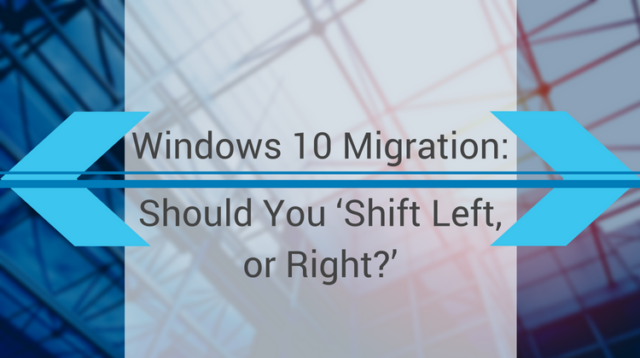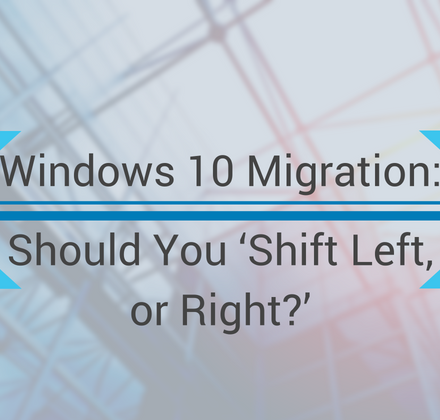The time has finally come when many organisations are taking on Windows 10 migration. The software was first released in July 2015 and has matured through six releases, bringing the stability that enterprises are looking for. Software vendors have had time to ensure that their applications are available in Windows 10 compatible versions. There is also the looming demise of support for Windows 7 due to the removal of hardware support or the need to migrate from it before the software support window closes.
Equally, user experience is now becoming a significant part of the conversation with any IT department. As developed economies achieve high levels of employment, there is more competition to attract the brightest and best talent. It is no longer just about the pay and benefits package, but now includes softer items like the type and mobility of devices and the inclusion of current applications.
Many organisations have built up significant technical debt within their organisations and their devices are now over four years old. They are therefore looking at large scale programmes to replace their end user compute estates and simultaneously migrate to Windows 10 on the new equipment.
The question becomes – how do they do this in the most appropriate way?
Shift Left
Traditional device replacement programmes have relied on a wave of upgrade activity propagating through the organisation. This usually took the form of buying new devices, shipping them to a staging location, perhaps provided by a third party, imaging them and delivering them to the end user. This is shown in the diagram below:

Many of the activities shown above can be more efficiently performed in the factory location using Dell’s Configuration Services capabilities. This approach removes the need for the staging location and a shipping leg, thereby reducing the carbon footprint of the organisation and contributing to their social responsibility goals.
Where staging centres have been used in the past, these have been connected to the enterprise network and the systems built there, rather than at the deskside. This usually involves extending automated OS deployment tooling into that location. Dell’s Connected Configuration solution, part of its ProDeploy Plus offer, allows enterprises to use our regional distribution hubs as their staging centres. The result is shown in the diagram below:

This approach saves time and money as the devices are imaged before they start their final delivery leg, arriving at the desk imaged and ready for the user to start work. Users only need to install their elective applications, those they use over and above the standard for their department. Providing that they have access to a self-service application store such as the Software Center included within SCCM, they can do this easily in a similar way to using their smartphone app store.
As this efficiency gain is driven from using the Dell factory and shifting activity left on the diagram, Dell refers to this as a Shift Left optimisation. We have the facilities to scale beyond those of most organisations in terms of throughput per day etc. Furthermore, our regional distribution hubs are situated such that all devices for a given territory will transit from that location anyway so it is much more efficient to use these locations than a third-party staging facility.
Data and settings migration may still require technical assistance, but these days more and more organisations are moving to Enterprise Files Sync and Share (EFSS) solutions such as OneDrive for Business, meaning that disciplined users only need to sign in to their tool and their data will start to be replicated to the new device.
Dell’s Managed Deployment teams can provide support for these deskside activities, should it be required, as well as providing resources to hand out the new devices and collect the legacy ones, dealing with packaging removal as part of the task.
Shift Right
Microsoft has been promoting the idea that Windows 10 can be provisioned (note: not imaged), using the AutoPilot process much more easily and at less cost than the traditional imaging methods. The idea here is that the device is shipped with a standardised OEM operating system image on it and a hardware device ID is registered with Microsoft to enable the AutoPilot process.
In practice, this transfers much of the work shown in figure 1 to the end user and is shown below.

This is often marketed as user enablement or empowerment, but what does that mean in practice?
The end user is now responsible for:
- Collecting their new device from a tech bar or similar distribution location.
- Perhaps unboxing the device and installing it to their desk.
- Going through a tailored Windows 10 out of box experience (OOBE).
- Logging into the device with their Azure Active Directory credentials thereby “joining the device to the domain” and drawing down policy settings and triggering mandatory software installs (as defined by their organisation) such as Office 365 Pro Plus.
- Installing additional applications from the Mobile Device Management Application Store or the Windows Store for Business (WSfB).
- Signing in to their EFSS solution (OneDrive for Business etc.).
- Waiting whilst their applications are downloaded and installed from the application store or WSfB. (This could take a while dependent on bandwidth and size of applications.)
- Waiting whilst their data synchronises, again bandwidth and volume dependent.
- Starting work with those applications and that data that is available to them whilst the remainder is delivered in the background.
Should We Shift Left, or Right?
In a previous blog post, Managing PCs the Modern Way, I considered the prime candidates for each of these deployment methodologies. To briefly reprise that post, Dell describes five key personas:
- Desk Centric – greater than 50% of time spent at a fixed desk location.
- Corridor Warrior – collaborative worker that divides their time between desk and meeting room locations but in one office or campus.
- On-the-Go Pro – highly mobile individual travelling between locations, cities and often countries. Often works on public WIFI or mobile communications.
- Remote Worker – greater than 50% of time spent at home.
- Specialist Worker – in many cases this category is driven by the hardware they use and Dell has defined three subcategories of this persona. It could be a Field Worker who needs ruggedized equipment, an Engineer who needs hardware that enables them to be creative perhaps using CAD/CAM software or a Creative user with peripherals such as the Dell Canvas.
It is my belief that from a management perspective and therefore a deployment methodology, Shift Right, enabled by modern management, best suits the On-the-Go Pro population and Specialist users with a similar level of mobility requirement. Where Remote Workers who primarily use Software as a Service (SaaS) apps, they may also be candidates.
Those users who are classified as Desk Centric, Corridor Warrior and the proportion of Remote Workers who use customer datacentre-hosted applications are probably best handled using the Shift Left methodology. This view is based on the fit of the post-deployment management technologies to the ways these users work.
Having said that, is it as simple as that? When Shift Left includes an engineer to address deskside deployment, it is like a waiter bringing your food to the table and serving it to you. Using that analogy, Shift Right could be described as a self-service buffet.
Dependent on the type of individual that fits in to your On-the-Go Pro category, asking them to do self-service may or may not be appropriate. Some will see it as end user empowerment whilst others will see it as the IT department cutting costs and offloading the work on to the users. Do you need to provide a “Tech Bar”-style walk-up help facility to address issues rather than overloading your Help Desk? How does this impact any outsource contract you might have? How do you quantify the loss of productivity for what could be some well-paid individuals whilst they wait for their applications to download?
These issues are soft or non-technical, but need to be addressed before simply opting for what appears on the face of it to be the “cheaper” option.
Summary
Dell’s Support and Deployment Services can help you identify the persona groups within your organisation using a mix of tooling and business analysis. Once we understand that mix and your readiness to adopt the modern management approach, we can help you define the roadmap to enable you to transform to your desired future state. In this way, we can help you find the right balance between Shift Left and Shift Right within your organisation. We will then stand with you through your deployment, bringing the relevant services to bear as you need them. The diagram below shows how we see these mapping against the personas, with those suiting Shift Left on the left and those suiting Shift Right on the right.

If you have any questions pertaining to Windows 10 migration or the Shift Left or Right methodologies, please feel free to contact me via the comments below.
Part of the Blog Series:
Windows 10 Migration: Best Practices for Making a User’s First Impression Great


